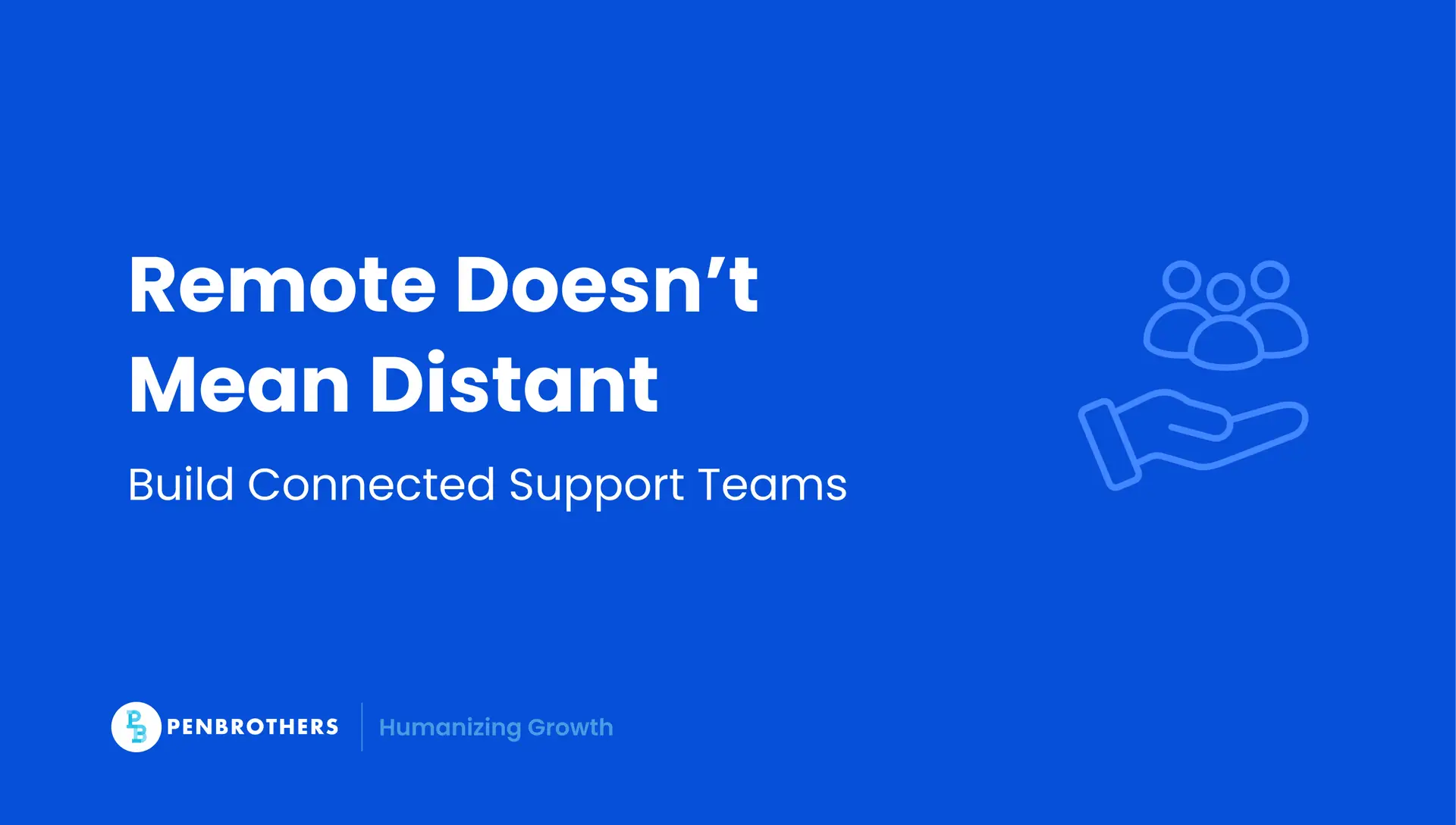What's Inside?
Building a Remote Customer Service Team That Feels In-House

Your startup just expanded across continents. Customers in New York, Sydney, and London expect instant support but your entire service team works remotely, from Manila to Mexico City. Every chat, email, and call shapes how your brand is remembered.
These remote reps aren’t just solving tickets, they’re your brand ambassadors. The question isn’t whether to go remote, but how to make your remote team feel in-house, connected, trusted, and fully aligned.
Why Remote Customer Service Is Now Core to Growth
1. Remote support has become the norm
The post-pandemic shift is permanent. Global companies have embraced remote and hybrid models not as temporary fixes, but as strategic workforce advantages. According to BoldDesk, 77% of remote workers report being more productive when working from home driven by flexibility, focus, and reduced commuting stress.
For customer support functions, that translates into faster responses and improved empathy without the overhead of office operations.
2. Accessibility drives loyalty
Customers today expect 24/7 accessibility, regardless of geography or time zone. Remote structures make that possible, enabling continuous coverage across continents while maintaining consistent service quality.
3. The business case: productivity, savings, and retention
- Cost efficiency: Remote setups can reduce operating expenses by 30%–40%, according to a Deloitte cost-optimization analysis.
- Automation advantage: Raffle.ai reports that automation and integrated knowledge systems can eliminate up to 97% of manual work, cutting search time by 85%.
- Human balance: Despite AI adoption, 75% of customers still prefer human agents for complex issues,
The takeaway? Remote customer service blends the best of both worlds, automation for speed and human empathy for loyalty.
What a “Feels In-House” Remote Team Looks Like
The best remote teams don’t just deliver support, they represent the brand’s voice and values.
Here’s what makes them stand out:
1. Shared Values and Empathy-Driven Culture
They don’t just memorize policies, they believe in your mission. These reps understand your brand voice, tone, and customer promise as deeply as internal employees. Their empathy is authentic because they know what your brand stands for.
A truly aligned remote team can turn a frustrated customer into a loyal one, not by following a script, but by reflecting your company’s values in every response.
2. Unified Systems and Full Visibility
Great service depends on shared infrastructure and transparency. When your remote reps use the same tools, dashboards, and KPIs as your core team, everyone works from one version of truth.
- Shared dashboards make performance visible and measurable
- Integrated tools prevent delays and miscommunication
- Unified reporting builds accountability and trust
This alignment eliminates the “out of sight, out of mind” problem and turns distance into data-driven clarity.
3. Seamless Communication and Collaboration
When communication is intentional, remote teams move like in-office ones. Daily huddles, async updates, and quick check-ins create rhythm and connection.
- Structured syncs keep everyone informed
- Open channels encourage collaboration and context sharing
- Async tools (like Loom, Slack threads, and Notion) sustain momentum across time zones
Explore how we help global companies find the right remote customer service jobs talent aligned with their brand culture.
The 5 Foundations of a High-Performing Remote Customer Service Team
Let’s break down the operational and cultural pillars that make remote support teams thrive.
1. Hire for Ownership and Fit
Customer service excellence isn’t just skill, it’s mindset. Look for:
- Self-starters who can manage time and outcomes independently
- Strong communicators who can resolve ambiguity through empathy
- Doers who thrive on accountability and care about customer success
Hiring for these traits ensures your reps act like owners, not operators. Learn more about identifying top talent in our guide on how to hire a customer experience specialist.
2. Build Culture Intentionally
Culture doesn’t happen by accident, it’s built through rituals and reinforcement:
- Host virtual “wins of the week” or customer success roundups
- Celebrate birthdays, milestones, and CSAT streaks
- Maintain transparent feedback loops so reps feel heard
- Pair new hires with mentors for faster integration
As Gallup’s 2024 Global Workplace Report found, engaged employees show 78% lower absenteeism, proof that culture directly affects output.
3. Equip with the Right Tools
Your tech stack defines your support experience. The essentials include:
- Help desk: BoldDesk, Zendesk, or Freshdesk
- Knowledge base: Tools like Raffle.ai for searchable FAQs
- Communication: Slack, MS Teams, or Zoom for daily syncs
- Analytics & QA: Real-time dashboards for tracking performance and customer sentiment
Well-equipped teams reduce response times and eliminate silos, key to delivering consistent global support.
4. Train Continuously
Great service requires continuous learning, not one-time onboarding.
- Create microlearning modules and recorded refreshers
- Use scenario-based roleplays and shadowing
- Turn customer feedback into quick learning loops
As a benchmark, companies with structured learning paths have 50% higher customer satisfaction scores (LinkedIn Workplace Learning Report, 2024).
5. Track What Matters
Measure performance holistically, not just ticket volume.
Key metrics:
- CSAT (Customer Satisfaction Score)
- FCR (First Contact Resolution)
- Average Response & Resolution Time
- Repeat Ticket Ratio
- Agent Engagement Index
Use these metrics to spot gaps early and coach proactively. The best teams turn data into development, not punishment.
Overcoming Common Remote Service Challenges
Every remote setup comes with hurdles. The best leaders anticipate and systemize solutions.
| Challenge | Why It Happens | How to Fix It |
| Communication breakdowns | Async workflows cause message gaps | Define channels for urgency, escalation, and context. Use shared documentation. |
| Motivation loss | Isolation and lack of recognition | Maintain visibility through recognition rituals and clear growth paths. |
| Security risks | Remote logins and personal devices | Use VPNs, MFA, and company-issued tools. Enforce device compliance. |
| Quality inconsistency | No direct supervision | Implement peer QA reviews and real-time dashboards for transparency. |
Proactive structures prevent remote friction from turning into customer frustration.
Turning Remote Reps into Brand Champions
The strongest remote teams don’t just meet KPIs, they embody the brand.
Here’s how to make that happen:
1. Connect Metrics to Mission
Numbers mean more when tied to something bigger. Show your team how CSAT, first contact resolution, and retention directly impact your company’s growth, reputation, and renewal rates. When agents understand that every positive conversation strengthens the brand, they start thinking beyond tickets, they think in terms of relationships.
2. Empower Autonomy Within Clear Boundaries
Micromanagement kills initiative. Empower reps to make small but meaningful decisions like approving refunds, offering goodwill credits, or escalating urgent cases without waiting for sign-off.
Set clear guidelines, but trust them to act with empathy and judgment. The best customer moments often come from reps who can say “yes” on the spot.
3. Use Storytelling to Build Emotional Connection
Data motivates the mind; stories move the heart. Share real customer stories in team syncs or newsletters, cases where great service turned a complaint into loyalty. Encourage agents to share their own wins, lessons, and behind-the-scenes problem-solving moments.
Storytelling helps remote teams see the human side of their impact and reinforces why their role matters.
4. Close the Feedback Loop
Your frontline sees what no dashboard can. Encourage them to report recurring customer pain points, product issues, or policy bottlenecks.
When management listens and acts on that feedback, reps feel valued and product teams gain insights straight from the source. This continuous loop strengthens both service quality and internal trust.
When reps feel ownership over the customer experience, their motivation shifts from compliance to care.
Scaling Smart: From 5 Reps to a Global Support Operation
Growth brings complexity. Here’s how to scale sustainably:
- Use data to determine scaling points. Rising ticket volume or response lag? Time to expand.
- Add structure. Introduce QA leads, team leads, and trainers as volume grows.
- Document processes early. SOPs, escalation paths, and knowledge bases keep quality consistent.
- Go offshore strategically. Offshore staffing in the Philippines offers cost-efficient scalability with cultural and linguistic alignment.
The Philippine BPO sector, for example, contributes nearly 10% of national GDP and employs over 1.3 million professionals, according to the IT and Business Process Association of the Philippines. It’s why top global companies build support teams there, balancing affordability with service excellence.
Explore more in our guide on work-from-home call center jobs and how remote teams in the Philippines drive business growth.
Final Thoughts
When your remote customer service team feels in-house, your customers feel the difference.
Penbrothers helps fast-growing startups and SMEs build remote customer service teams in the Philippines, trained, managed, and aligned with your brand values.
You’ll get:
- Fully supported hiring, payroll, and compliance
- Access to top-tier Filipino support talent
- A dedicated success manager ensuring seamless integration
Your customers deserve consistency. Your brand deserves a team that feels like family, no matter where they log in from.
Partner with Penbrothers and start building your dream support team today.
*This article was crafted with the support of AI technology and refined by a human editor.





